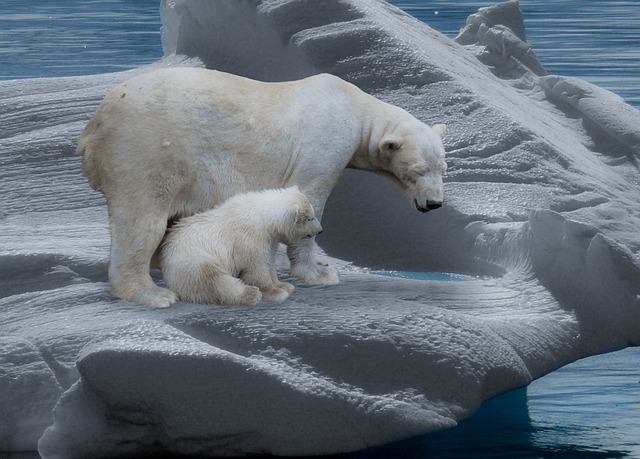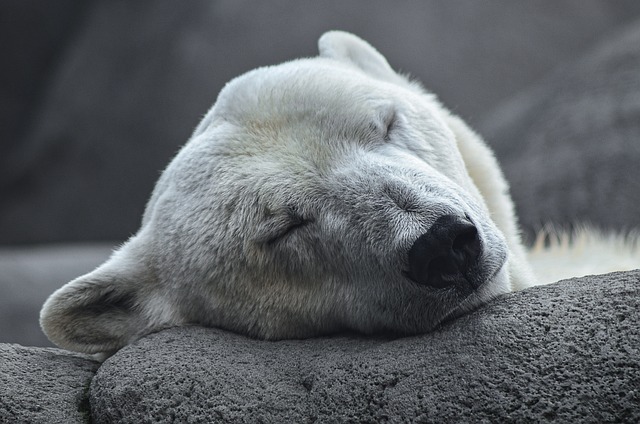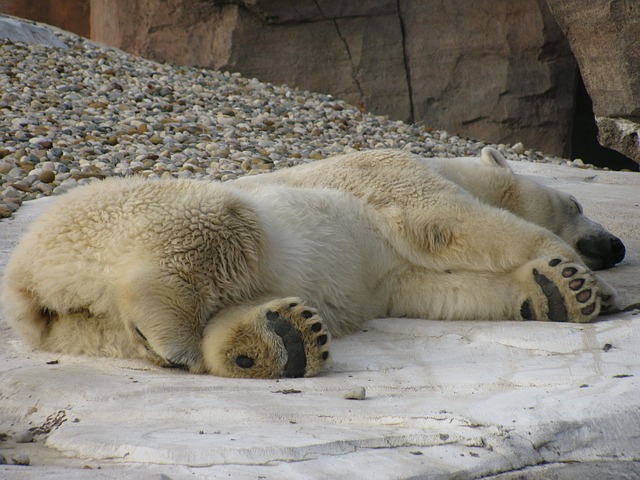Welcome to the frozen North, where the mighty polar bears roam. These majestic creatures have captured our fascination for centuries with their incredible strength and ability to survive in one of the harshest environments on Earth. Understanding their behavior and characteristics is crucial for their survival, and it also allows us to gain a deeper appreciation for these magnificent animals.
In this article, we will take a closer look at polar bears and their fascinating ways of life. From their physical adaptations to their social behaviors, we will uncover intriguing facts that will leave you in awe. We will also discuss the threats facing polar bears and the conservation efforts in place to protect them. So, bundle up and join us on a frozen odyssey as we explore the world of the mighty polar bears.

The Mighty Polar Bear: Physical Characteristics and Adaptations
Polar bears are truly remarkable creatures, known for their immense size and strength. These majestic animals are perfectly adapted to survive in the frozen North, where temperatures can drop to -50°C (-58°F). In this section, we will delve into their physical characteristics and fascinating adaptations that allow them to thrive in one of the harshest environments on Earth.
Size and Strength:
Polar bears are the largest land carnivores in the world, with adult males weighing up to 1,500 pounds and standing at a towering height of 10 feet. Their massive size is a result of their high-fat diet, which is essential for keeping them warm in the Arctic climate. Despite their bulky appearance, polar bears are incredibly agile and can move swiftly on both land and ice, making them powerful hunters.
Adaptations for Arctic Survival:
One of the most notable adaptations of polar bears is their thick, white fur. Contrary to popular belief, their fur is not actually white, but made up of transparent hollow tubes that reflect light, giving it a white appearance. This insulating fur not only keeps them warm but also helps them blend in with their surroundings while hunting. In addition, polar bears have a layer of fat under their skin, which acts as an extra insulator against the cold.
Their large paws are another remarkable adaptation for life in the Arctic. These massive paws, which can measure up to 12 inches in diameter, act as snowshoes, distributing their weight over a larger area and preventing them from sinking into the snow. They also have sharp claws that provide traction on the ice and help them catch prey.
Swimming and Diving Abilities:
With the Arctic being mostly covered in water, it is no surprise that polar bears are excellent swimmers. They have a streamlined body shape, which makes it easier for them to navigate through the water. Their front paws serve as powerful paddles, while their hind legs act as rudders. They can swim for hours at a time and travel long distances in search of food.
But what is truly impressive is their diving ability. Polar bears can hold their breath for up to two minutes and dive to depths of 15 feet in search of food. This is made possible by their ability to slow down their heart rate and reduce their oxygen consumption while diving.
In conclusion, polar bears are perfectly adapted to survive in the extreme conditions of the Arctic. From their size and strength to their unique fur and swimming abilities, these amazing creatures have evolved to thrive in a frozen world. However, with the changing climate, these adaptations are being put to the test, posing a threat to their survival. It is important for us to understand and appreciate these adaptations and work towards protecting the polar bears and their fragile ecosystem.
The Arctic Diet: What Do Polar Bears Eat?
Polar bears are known as fierce predators of the Arctic, but what exactly do they eat to survive in the frozen North? These magnificent creatures have adapted to their harsh environment and have a diet that is perfectly suited for their survival.
The primary food source for polar bears is seals, specifically ringed seals and bearded seals. These seals make up about 95% of a polar bear’s diet, with occasional meals of walrus, beluga whales, and even narwhals. However, polar bears are opportunistic hunters and will eat any available food source, including fish, birds, and even reindeer. This diverse diet is necessary for their survival in such a harsh and unpredictable environment.
Polar bears hunt for their prey on the sea ice, using their keen sense of smell to locate their potential meal. They are also excellent swimmers and will dive deep into the water in search of seals. Once a polar bear has located its prey, it will use its white fur as camouflage to blend in with the snow and ice, making it easier to sneak up on the unsuspecting seal. They also use their large paws, which have strong claws, to break through the ice and grab their prey.
Interesting Facts:
– A polar bear’s sense of smell is so powerful that it can detect the scent of a seal from up to 1 mile away.
– Polar bears are patient hunters and can wait for hours on the ice for the perfect moment to strike.
– Their hunting success rate is only about 10%, making each successful kill crucial for their survival.
One of the most fascinating facts about polar bears’ eating habits is their ability to consume an incredible amount of food in just one sitting. During the late summer and early fall, polar bears will gorge on their prey, consuming up to 100 pounds of meat in one meal. This binge-eating helps them build up a thick layer of fat that will sustain them during the long winter months when food is scarce.
However, the changing Arctic climate has had a significant impact on polar bears’ food sources. With the melting of sea ice, polar bears have less access to their primary prey, making it challenging for them to build up fat reserves. This puts them at a higher risk of starvation and can lead to conflicts with humans as they search for alternative food sources.
In addition to their diet, polar bears also have unique adaptations that help them survive in the Arctic. For example, they have a small intestine and a large liver, making it easier for them to digest large amounts of fat. They also have a thick layer of blubber, which helps to insulate them from the cold and maintain their body temperature.
In conclusion, the diet of polar bears is a crucial aspect of their survival in the frozen North. Their ability to adapt to a changing Arctic environment has allowed them to thrive and maintain their position as the apex predator of the region. As climate change continues to impact their food sources, it is more important than ever to protect these magnificent creatures and their habitat. By understanding their diet and behaviour, we can work towards preserving these incredible animals for generations to come.

Social Creatures: Polar Bear Family Life
Polar bears may have a fierce reputation as solitary hunters, but they are also social creatures who have complex family dynamics. In this section, we will dive deeper into the social behaviour of polar bears and discover their unique family life.
Solitary by Nature:
Contrary to popular belief, polar bears are not strictly solitary animals. While they do spend a majority of their time alone, they do occasionally come into contact with other bears, especially during the breeding season. These interactions can range from friendly play to aggressive confrontations, depending on the situation and the bears involved.
Mother-Offspring Bond:
One of the most heart-warming aspects of polar bear family life is the bond between a mother and her cubs. After giving birth in their dens, mothers will spend the next few years raising and protecting their young. During this time, the mother becomes fiercely protective and will do anything to ensure the survival of her cubs.
Hibernating Mothers:
What makes polar bear mothers even more impressive is their ability to give birth and nurse their cubs while hibernating. This unique adaptation allows them to conserve energy and resources during the harsh Arctic winters. However, it also means that mothers must go without food for several months, relying solely on their fat reserves to sustain themselves and their cubs.
Sibling Relationships:
Polar bear cubs will stay with their mother for about two and a half years, during which time they will form strong sibling bonds. These bonds will eventually dissolve when the cubs become independent and venture out on their own. Interestingly, polar bear siblings will often reunite later in life, recognizing each other through their sense of smell.
Challenges Faced by Polar Bear Families:
Polar bears are facing many challenges due to climate change, and their family life is no exception. With the melting sea ice, polar bears are struggling to find suitable habitats to raise their young. This may lead to increased competition for resources and potential conflict between bears, as well as a decline in reproductive success.
Conservation Efforts:
The importance of family units for polar bears is recognized by conservationists, who are working towards protecting their habitats and preserving their way of life. Some organizations have developed initiatives to reduce human-polar bear conflicts and promote sustainable tourism practices in the Arctic. These efforts aim to ensure that polar bears can continue to thrive in their natural habitats for generations to come.
In conclusion, while polar bears may be fierce and independent hunters, they also have a more complex social side. Their family life is essential for their survival, and understanding their behaviour and dynamics is crucial for their conservation. Through conservation efforts and sustainable practices, we can help protect polar bear families and their Arctic home.
Surprising Facts About Polar Bears
As one of the most fascinating creatures in the animal kingdom, polar bears never cease to amaze us with their incredible abilities and traits. In this section, we will delve into some surprising facts about polar bears that will leave you in awe.
Ability to Go Months Without Eating or Drinking:
Polar bears have an amazing ability to survive for long periods without food or water. During the summer months, when the sea ice melts, polar bears may go without eating for several months. This is because they rely on the fat stores from their previous successful hunts. In fact, a polar bear’s fat can make up to 50% of its body weight, allowing them to go without food for up to seven months.
Intelligence and Problem-Solving Skills:
Polar bears have been observed displaying impressive levels of intelligence and problem-solving skills. They have been seen using tools, such as blocks of ice or chunks of snow, to catch their prey. For example, they will use their paws to create holes in the ice and wait patiently for seals to come up for air. They have also been seen using sticks or rocks to break through the ice to reach seals.
Communication:
Polar bears have a complex communication system that includes vocalizations and body language. They use a variety of sounds, such as growls, huffs, and roars, to communicate with each other. They also use body language, such as head tilting and paw swatting, to convey their intentions and emotions. Researchers have even found that polar bears can use their sense of smell to communicate with other bears over long distances.
Relationship with Humans:
Contrary to popular belief, polar bears are not naturally aggressive towards humans. In fact, they typically avoid human contact and are only likely to attack when feeling threatened or when they are starving. In the Arctic, native communities have learned to coexist with polar bears and even consider them to be an important part of their culture and traditions.
Conservation Efforts:
Polar bears are currently listed as a threatened species due to the ongoing effects of climate change and loss of sea ice. To protect these magnificent creatures, various conservation efforts are in place, including research on polar bear populations and habitats, as well as initiatives to reduce human-bear conflicts. Additionally, governments and organizations are working towards reducing carbon emissions and promoting sustainable practices to preserve the polar bear’s fragile ecosystem.
Conclusion:
Polar bears continue to surprise and captivate us with their remarkable abilities and unique characteristics. Their resilience and adaptability in the harsh Arctic environment are truly admirable. As we continue to learn more about polar bears, we must also take action to protect them and their home in the frozen North. By working together, we can ensure the survival of this magnificent species for generations to come.

Threats to Polar Bears
Despite their impressive adaptations and survival skills, polar bears are facing increasing threats in their frozen home of the Arctic. These magnificent creatures are not only facing challenges due to their changing environment, but also human interference and activities. In this section, we will explore the current threats to polar bears and their vulnerable habitat.
Climate change is one of the most pressing threats to polar bears. The Arctic is warming at an alarming rate, causing sea ice to melt earlier and form later, depriving polar bears of their primary hunting ground. As sea ice continues to disappear, polar bears are forced to travel longer distances to find food, leading to exhaustion and starvation. According to a study by the U.S. Geological Survey, two-thirds of the world’s polar bears could disappear by 2050 if climate change continues at its current pace.
Loss of sea ice also affects polar bears’ ability to breed and raise their young. Female polar bears typically give birth during winter, relying on sea ice to create dens for their cubs. However, with the ice melting earlier, cubs are forced to swim long distances with their mothers, putting them at risk of drowning or separating from their mothers. This disruption in their breeding patterns not only affects the current polar bear population but also has long-term consequences for their survival.
Human activities such as oil and gas exploration, shipping, and tourism also pose a threat to polar bears. As sea ice retreats, more areas become accessible for these activities, increasing the risk of disturbance to polar bears. Oil spills can harm polar bears’ fur and skin, making it difficult for them to regulate their body temperature in the freezing Arctic. Polar bears are also drawn to human settlements in search of food, leading to conflicts and potential harm to both polar bears and humans.
In addition to these direct threats, indirect factors such as pollution and overhunting also impact polar bears. As top predators, polar bears are vulnerable to the accumulation of pollutants in their food sources, which can have detrimental effects on their health and reproductive abilities. Overhunting, both legally and illegally, also threatens the polar bear population, as it reduces their food supply and disrupts their natural balance within the ecosystem.
The consequences of these threats are already evident in the declining polar bear population. According to the International Union for Conservation of Nature, polar bears are listed as a vulnerable species, with their population estimated to be between 22,000 to 31,000 individuals. If these threats continue, polar bears could face extinction in the near future.
It is essential to take action to protect polar bears and their fragile habitat. Conservation efforts such as reducing carbon emissions, protecting sea ice, and creating protected areas for polar bears are crucial in preserving their population. Individuals can also contribute by reducing their carbon footprint, supporting sustainable tourism practices, and advocating for stricter regulations to protect polar bears.
In conclusion, polar bears face multiple threats in their frozen home, and it is up to us to take action to protect them. We must address the root causes of these threats and work towards creating a sustainable future for both polar bears and the Arctic ecosystem. Let us join hands and protect these powerful creatures, ensuring their survival for generations to come.
